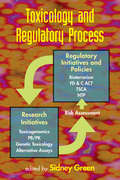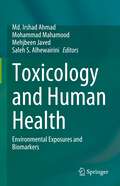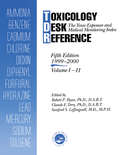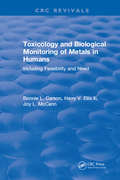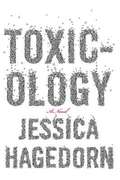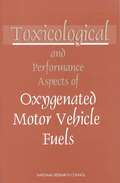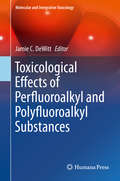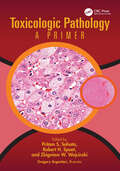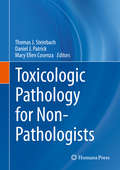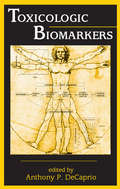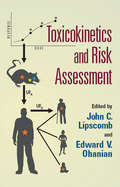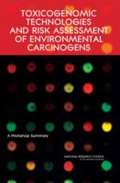- Table View
- List View
Toxicology and Regulatory Process
by Sidney GreenProviding detailed examples and valuable discussions of the development of specific methods, approaches, and legislation, this reference presents the latest information on the impact of toxicology on the regulatory process and illustrates the interrelationship between toxicology and the regulation of chemicals, pharmaceutical compounds, and food su
Toxicology and Human Health: Environmental Exposures and Biomarkers
by Md. Irshad Ahmad Mohammad Mahamood Mehjbeen Javed Saleh S. AlhewairiniThis contributed volume brings out a comprehensive collection of information on environmental toxicology, its impact on living organisms in general and human health in particular. The main focus of this book is to address human health issues and risk assessment. Toxicological studies help in understanding the impact of harmful substances including both natural and synthetic chemicals on organisms and their environment. Contributions in the title include both laboratory and field based studies with a focus on human health. Moreover, day by day, there is an increase in the range of chemicals from pharmaceutical and other industries, agricultural runoffs, medicine, and many other sources which continuously contribute to the earth's chemical load. Almost all the countries are facing great difficulties in responding to the crucial and immediate need for effective management of such contaminants. The title compiles studies in regards to environmental toxicology and its effect on human health. This book provides critical information and knowledge that can be used by regulatory agencies, decision-makers, policy makers, graduate and post-graduate students, researchers, environmental toxicologists, etc, and others to put programs and policies in place to limit our exposures to these substances thereby preventing or reducing the likelihood that a disease or other negative health outcomes would occur.
Toxicology and Epigenetics
by Saura C. SahuEpigenetics is the study of both heritable and non-heritable changes in the regulation of gene activity and expression that occur without an alteration in the DNA sequence. This dynamic and rapidly developing discipline is making its impact across the biomedical sciences, in particular in toxicology where epigenetic differences can mean that different individuals respond differently to the same drug or chemical.Toxicology and Epigenetics reflects the multidimensional character of this emerging area of toxicology, describing cutting-edge molecular technologies to unravel epigenetic changes, the use of in vivo and in vitro models, as well as the potential use of toxicological epigenetics in regulatory environments. An international team of experts consider the interplay between epigenetics and toxicology in a number of areas, including environmental, nutritional, pharmacological, and computational toxicology, nanomaterials, proteomics and metabolomics, and cancer research.Topics covered include:environment, epigenetics and diseasesDNA methylation and toxicogenomics chromatin at the intersection of disease and therapyepigenomic actions of environmental arsenicalsenvironment, epigenetics and cardiovascular healthtoxicology, epigenetics and autoimmunityocular epigenomics: potential sites of environmental impact in development and diseasenuclear RNA silencing and related phenomena in animalsepigenomics - impact for drug safety sciencesmethods of global epigenomic profilingtranscriptomics: applications in epigenetic toxicologyToxicology and Epigenetics is an essential insight into the current trends and future directions of research in this rapidly expanding field for investigators, toxicologists, risk assessors and regulators in academia, industry and government.
Toxicology and Environmental Health Information Resources: The Role of the National Library of Medicine
by Carolyn E. Fulco Catharyn T. Liverman Carrie E. Ingalls Howard M. KipenThe environment is increasingly recognized as having a powerful effect on human and ecological health, as well as on specific types of human morbidity, mortality, and disability. While the public relies heavily on federal and state regulatory agencies for protection from exposures to hazardous substances, it often looks to health professionals for information about routes of exposure and the nature and extent of associated adverse health consequences. However, most health professionals acquire only a minimal knowledge of toxicology during their education and training.In 1967 the National Library of Medicine (NLM) created an information resource, known today as the Toxicology and Environmental Health Information Program (TEHIP). In 1995 the NLM asked the Institute of Medicine to examine the accessiblity and utility of the TEHIP databases for the work of health professionals.This resulting volume contains chapters on TEHIP and other toxicology and environmental health databases, on understanding the toxicology and environmental health information needs of health professionals, on increasing awareness of information resources through training and outreach, on accessing and navigating the TEHIP databases, and on program issues and future directions.
Toxicology Desk Reference: The Toxic Exposure & Medical Monitoring Index
by Robert RyanA source of medical, legal and regulatory information on the toxicology of human exposure to metals and chemicals, this three-volume set is designed to be the first resource professionals turn to when formulating an opinion and developing a programme. It is annually updated to provide the latest information on over 150 chemical agents in a standar
Toxicology Biological Monitoring of Metals in Humans
by Bonnie L. CarsonAs one of many tasks of an analytical chemistry program sponsored by the office of Pesticides and Toxic Substances, Field Studies Branch, U.S. Environmental Protection Agency (EPA) (EPA Prime Contract No. 68-02-3938), Midwest Research Institute (MRI) prepared these summaries of the mammalian toxicology of 52 individual elements (metals and metalloids) and the lanthanides (rare earth elements). MRI is assisting the EPA in developing protocols for the monitoring of selected metals and organic compounds in the blood of the general U.S. population. The monitoring will enable evaluation of changes in the blood levels over time and any trends associated with instituted control measures. This review will help EPA select the metals to be included in the monitoring effort based on toxicity, relative exposure, and the ability of blood measurements to reflect exposure.
Toxicology
by Jessica Hagedorn"Highly entertaining. . . [Hagedorn] is an exceptional storyteller. " -The Boston Globe Jessica Hagedorn's ferociously entertaining new novel centers on two women who are neighbors in Manhattan's West Village: Mimi Smith, a filmmaker whose only screen credit is a notorious low-budget slasher movie, and Eleanor Delacroix, a legendary, scandalous literary figure now nearing eighty. Their personal and artistic lives begin to converge in unexpected ways as Eleanor grieves over the death of her longtime lover, the renowned painter Yvonne Wilder, and as Mimi confronts the challenges presented by the mysterious disappearance of her boyfriend, by her newly sober if still somewhat loopy brother, and by her wayward teenage daughter. Toxicology is a fearless, playful, and savagely funny novel about the collision of art, fame, money, love, desire, and mortality. .
Toxicological and Performance Aspects of Oxygenated Motor Vehicle Fuels
by National Research CouncilThis book reviews a draft report from the federal government that assesses the effects of oxygenated gasoline on public health, air quality, fuel economy, engine performance, and water quality. In addition to evaluating the scientific basis of the report, the book identifies research needed to better understand the impacts of oxygenated fuels. Methyl tertiary-butyl ether (MTBE), which is intended to reduce carbon monoxide pollution during winter, is the most commonly used additive in the federal oxygenated fuels program. MTBE has been implicated in complaints by the public of headaches, coughs, and nausea. Other questions have been raised about reduced fuel economy and engine performance and pollution of ground water due to the use of MTBE in gasoline. The book provides conclusions and recommendations about each major topic addressed in the government's report.
Toxicological Testing Handbook: Principles, Applications and Data Interpretation
by David Jacobson-Kram Kit A. KellerFurnishing essential data on all areas of toxicity testing, this Second Edition provides guidance on the design and evaluation of product safety studies to help ensure regulatory acceptance. Every chapter highlights regulatory requirements specific to the United States, Europe, and Japan, and in addition to expanded information on da
Toxicological Risks of Selected Flame-Retardant Chemicals
by National Research CouncilIn its fiscal 1999 appropriations report, Congress directed the US Consumer Product Safety Commission to arrange for an independent study by the National Research Council to conduct toxicological assessments for flame-retardant (FR) chemicals that are likely to be used on furniture upholstery. This report evaluates the toxicological, epidemiological, and exposure data on 16 specified FR chemicals and characterizes risks to human health from exposure to furniture upholstery treated with such chemicals. Introductory chapters discuss the study purposes, assessment process, and methodology. An appendix presents information on the durability and permanence of flame-retardancy in fabrics. The volume is not indexed. Annotation c. Book News, Inc. , Portland, OR (booknews. com)
Toxicological Risk Assessment: Biological and Statistical Criteria (Routledge Revivals #1)
by David B. Clayson Daniel R. Krewski Ian C. MunroFirst Published in 1986, this two-volume set explores the methods of toxicological risk assessment. Carefully compiled and filled with a vast repertoire of notes, diagrams, and references this book serves as a useful reference for toxicologists and other practitioners in their respective fields.
Toxicological Risk Assessment of Chemicals: A Practical Guide
by Elsa Nielsen Grete Ostergaard John Christian LarsenUnlike many existing books on toxicology that cover either toxicity of a particular substance or toxicity of chemicals on particular organ systems, Toxicological Risk Assessment of Chemicals: A Practical Guide lays out the principle activities of conducting a toxicological risk assessment, including international approaches and methods for the risk
Toxicological Risk Assessment for Beginners
by José A. Torres Sol BobstThis book serves as a comprehensive introductory guide to the practical aspects of risk assessment. Chapters include clearly defined objectives and summaries. The book includes: hazard identification, dose-response, exposure assessment, risk characterization, chemical mixtures, epidemiology, emerging issues and global perspectives with accessible language. The book concludes with a set of hypothetical case studies. Toxicological Risk Assessment for Beginners aims not to create an expert, but rather to provide readers with their first understanding of the risk assessment topic. This book was designed with the student in mind. We simplify a complex process for beginners and balance theory with practical aspects, but remain fluid enough to increase difficulty with case studies. By incorporating an action based, step by step approach to learning the risk assessment process, this book provides its readers with an elementary understanding of how the risk assessment process is initiated, developed and finished, making it a valuable guide for graduate students, post-doctoral fellows and early career scientists in industry.
Toxicological Effects of Perfluoroalkyl and Polyfluoroalkyl Substances
by Jamie C. DewittThis book serves as a timely and comprehensive overview of the latest science for perfluoroalkyl and polyfluoroalkyl substances (PFASs), covering the development of methods for assessing PFASs in biological fluids and tissues as well as the current knowledge regarding their toxicity to vertebrate organisms. This book includes chapters on human and wildlife exposure/body burdens, reviews of metabolism and toxicological effects by organ system/developmental stage and aspects of PFAS toxicity that are driving PFAS research and regulatory oversight. Toxicological Effects of Perfluoroalkyl and Polyfluoroalkyl Substances provide critical assessments of the most controversial topics surrounding toxicological evaluation of PFASs to give readers an expert perspective on the issues. Emphasis is placed on the integration of modes and mechanisms of action with functional endpoints that are relevant to human and wildlife health. This book will be a useful resource for toxicologists, environmental chemists, risk assessors and researchers with an interest in the class of compounds known as perfluoroalkyl and polyfluoroalkyl substances.
Toxicological Effects of Methylmercury
by National Research CouncilMercury is widespread in our environment. Methylmercury, one organic form of mercury, can accumulate up the aquatic food chain and lead to high concentrations in predatory fish. When consumed by humans, contaminated fish represent a public health risk.Combustion processes, especially coal-fired power plants, are major sources of mercury contamination in the environment. The U.S. Environmental Protection Agency (EPA) is considering regulating mercury emissions from those plants.Toxicological Effects of Methylmercury reviews the health effects of methylmercury and discusses the estimation of mercury exposure from measured biomarkers, how differences between individuals affect mercury toxicity, and appropriate statistical methods for analysis of the data and thoroughly compares the epidemiological studies available on methylmercury. Included are discussions of current mercury levels on public health and a delineation of the scientific aspects and policy decisions involved in the regulation of mercury.This report is a valuable resource for individuals interested in the public health effects and regulation of mercury. The report also provides an excellent example of the implications of decisions in the risk assessment process for a larger audience.
Toxicological Assessment of Combined Chemicals in the Environment
by De-Sheng Pei Yiyun LiuComprehensive resource covering toxicology fundamentals, distribution of pollutants in the environment, and research methodologies for toxicological assessment of chemical mixtures Toxicological Assessment of Combined Chemicals in the Environment offers an in-depth exploration of various approaches and molecular mechanisms regarding how minor alterations in chemical mixtures can influence an organism’s toxicity, along with discussion of the challenges associated with assessing mixtures. The first section of the book provides a concise introduction to the background and significance of combined toxicity. Section two delves into the primary sources and enrichment mechanisms of different chemical mixtures, elucidating the biological exposure pathways of these compounds. Section three introduces both classical and emerging toxicological research models in detail. Building on the descriptions of compound emission, migration, accumulation, and transformation processes, and the analysis of combined molecular toxicity in the preceding sections, section four introduces computer mathematical modeling methods for hazard assessment of compound mixtures. The final section details the challenges and future trends in this field. Written by a highly qualified author and seasoned research contributor in the field, Toxicological Assessment of Combined Chemicals in the Environment covers sample topics including: The degradation, oxidation, absorption, distribution, biotransformation, and excretion of various compounds in both the environment and in organisms A variety of cell models and in vivo research models of model organisms, supplemented with case studies Combined molecular toxicity mechanisms of heavy metals, pesticides, persistent organic pollutants (POPs), and pharmaceutical and personal care products (PPCPs) Principal sources, fate, and mechanism of chemical mixtures in the environment, as well as experimental designs and sampling strategies for combined toxicity studies based on concentrations Toxicological Assessment of Combined Chemicals in the Environment serves as a valuable reference for researchers, students, and policymakers involved in environmental management and protection. It is particularly relevant for toxicologists, risk assessors, and those engaged in the molecular modeling of toxic mixtures.
Toxicologic Pathology: Nonclinical Safety Assessment, Second Edition
by Chirukandath Gopinath Pritam S. Sahota James A. Popp Jerry F. Hardisty Page BouchardFollowing the success of the first edition, this book is designed to provide practical and timely information for toxicologic pathologists working in pharmaceutical drug discovery and development. The majority of the book (Organ Systems) will provide detailed descriptions of histopathological lesions observed in drug development. In addition, it will provide information to assist the pathologist in making determinations of the origin of lesions as well as its relevance to human risk. Toxicologic Pathology: Nonclinical Safety Assessment, Second Edition includes 2 new concept chapters. The first of the new chapters address approaches for the evaluation of unique therapeutic modalities such as cell therapies, gene therapies, and gene expression knockdown therapies. While these still represent new developing therapeutic approaches, there has been significant experience with the therapeutic modalities in the last 5 years. The second new chapter addresses the nonclinical safety assessment of medical devices, a topic of increasing importance that was not addressed in a unique chapter in the first edition. The other concept chapters have been updated and cover important topics including the overview of drug development; principles of nonclinical safety assessment; an introduction to toxicologic pathology; techniques used in toxicologic pathology, clinical pathology, toxicokinetics, and drug development toxicogenomics; and spontaneous lesions. The 13 organ system chapters provide the specifics related to pathologic characteristics, differential diagnosis, and interpretation of toxic responses in each organ system. These chapters are specifically important for the bench pathologist but also for the toxicologist who interacts with pathologists and function as study toxicologists and project team representatives in the drug development arena.
Toxicologic Pathology: Nonclinical Safety Assessment
by Pritam S. Sahota Zbigniew W. Wojcinski Page R. Bouchard Shannon Wallace Vanessa L. Schumacher David. A. SabioThe new edition provides practical and timely information for toxicologic pathologists working in drug discovery and development. The introductory concept chapters are consolidated into two more concise and better-organized introductory chapters. The two concept chapters introduce the reader to pharmaceutical R&D, the role of the pathologist in the process, and critical partner scientific disciplines with whom the pathologist will collaborate. In this revision, the organ system chapters incorporate more consistent commentary and guidance on the molecular mechanism of action, human translational relevance, and regulatory impact of pathological findings as they are described in these chapters.Key Features: Aids scientists in understanding spontaneously occurring and compound-related pathological findings Features three new well-respected scientists on the editorial team Includes more consistent commentary and guidance in the organ system chapters
Toxicologic Pathology: A Primer
by Gregory ArgentieriThere has been an enormous growth of interest in the field of toxicologic pathology and particularly on its impact on nonclinical safety assessment in global drug development and in the environment. Toxicologic pathologists play an important role in detecting test article-related adverse effects by characterizing morphologic changes in animal tissues and/or body fluids under prescribed study conditions or less clearly defined conditions in the environment and in the interpretation of these findings relative to human risk. In fact, pathology evaluation is often the single most important decision-making factor in nonclinical safety assessments as 80% of drug candidate attrition has been attributed to pathology findings in toxicity studies. There are currently no primers or basic overviews covering the field of toxicologic pathology, whereas there are at least several basic books that cover the sister field of toxicology.Toxicologic Pathology: A Primer is a practical, easy-to-use reference designed to contain core information provided by board-certified veterinary pathologists, all experts in the field. The Primer contains the basic, underlying principles of toxicologic pathology at the introductory level; thus it will be valuable to the veterinary pathology student who may be considering a career in the field as well as a companion to the seasoned toxicologic pathologist who wants a succinct refresher. The Primer is arranged as chapters presenting each major organ system preceded by an overview chapter covering the field of toxicologic pathology followed by a “concept” chapter describing the role of toxicologic pathology in drug development. Photomicrographs and illustrations provide visual context.The organ system chapters provide histopathologic descriptions of lesions observed in toxicity studies of test articles in drug development and testing of chemicals that may negatively impact the environment. Each organ system chapter provides additional information related to a particular lesion to aid the reader in better understanding its toxicologic significance relative to human risk.Each organ system chapter contains: A brief introduction A succinct description of the anatomy and physiology of the system Descriptions of the most important pathological lesions Differential diagnoses Biological consequences, pathogenesis, and/or mechanism of lesion formation Associated clinical pathology correlates Nonclinical safety scientists such as study directors, non-pathology-oriented contributing scientists such as senior toxicology report reviewers, scientific management of Contract Research Organizations (CROs), and students should find the Primer useful in helping them understand the fundamentals of toxicologic pathology.
Toxicologic Pathology for Non-Pathologists (Springer Protocols Handbooks Ser.)
by Thomas J. Steinbach Daniel J. Patrick Mary Ellen CosenzaThis extensive volume began as a short course primarily geared toward toxicologists who want to expand their understanding of toxicologic pathology in order to be better study directors while also proving to be of great interest to other drug development scientists and regulatory reviewers. The overall goal is to help non-pathologists understand, contextualize, and communicate the pathology data and interpretations from the study pathologist in a practical and usable format. Within the book, readers will find an overview of general pathology concepts that include fundamental vocabulary and the basics of pathophysiological processes, along with numerous chapters devoted to pathology in specific organ systems as well as topics such as biomarkers, correlation of clinical pathology endpoints (chemistry and hematology) with microscopic changes, and well-known pathology findings for classes of toxic substances. Authoritative, practical, and comprehensive, Toxicologic Pathology for Non-Pathologists aims to help non-pathologists understand, converse in, and apply a basic understanding of pathology in their day-to-day careers.
Toxicologic Biomarkers
by Anthony P. DeCaprioResponding to the explosion of advances in the use of biomarkers to efficiently, rapidly, and economically evaluate the health effects of chemical entities, this authoritative reference provides a detailed overview of the theory, development, and practical application of biomarkers in the toxicological, environmental, forensic, and pharmaceutical s
Toxicologic Assessment of Jet-Propulsion Fuel 8
by Subcommittee on Jet-Propulsion Fuel 8This report provides a critical review of toxicologic, epidemiologic, and other relevant data on jet-propulsion fuel 8, a type of fuel in wide use by the U. S. Department of Defense (DOD), and an evaluation of the scientific basis of DOD’s interim permissible exposure level of 350 mg/m3
Toxicologic Assessment Of The Army's Zinc Cadmium Sulfide Dispersion Tests
by Subcommittee On Zinc Cadmium SulfideDuring the 1950s and 1960s, the U.S. Army conducted atmospheric dispersion tests in many American cities using fluorescent particles of zinc cadmium sulfide (ZnCdS) to develop and verify meteorological models to estimate the dispersal of aerosols. Upon learning of the tests, many citizens and some public health officials in the affected cities raised concerns about the health consequences of the tests. This book assesses the public health effects of the Army's tests, including the toxicity of ZnCdS, the toxicity of surrogate cadmium compounds, the environmental fate of ZnCdS, the extent of public exposures from the dispersion tests, and the risks of such exposures.
Toxicokinetics and Risk Assessment
by John C. Lipscomb Edward V. OhanianToxicokinetics in Risk Assessment discusses the noncancer risk assessment process and its reliance on uncertainty factors in order to facilitate the continued study and refinement of the scientific basis for health risk assessment. This text clearly demonstrates the application of physiologically-based pharmacokinetic (PBPK) modeling in human healt
Toxicogenomic Technologies and Risk Assessment of Environmental Carcinogens: A Workshop Summary
by National Research CouncilToxicogenomics is a discipline that combines expertise in toxicology, genetics, molecular biology, and environmental health to help understand the response of living organisms to stressful environments. The National Research Council convened a workshop to discuss how toxicogenomic data could be applied to improve risk assessments, particularly cancer risk from environmental exposure to chemicals. Risk assessments serve as the basis of many public-health decisions in environmental, occupational, and consumer protection from chemicals. The workshop provided a forum for communities of experts, including those working in "-omics" and those in the policy arena, to discuss where their fields intersect, and how toxicogenomics could address critical knowledge gaps in risk assessments.
